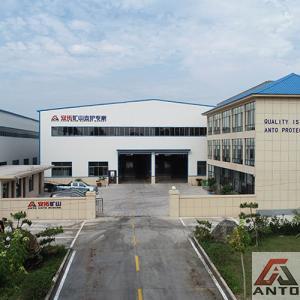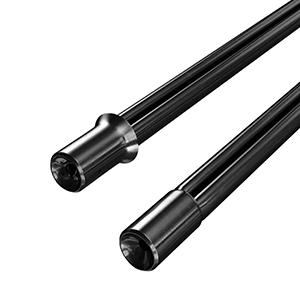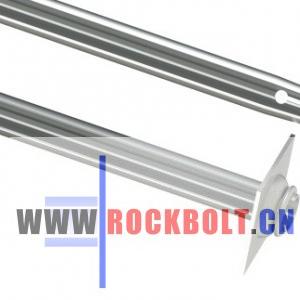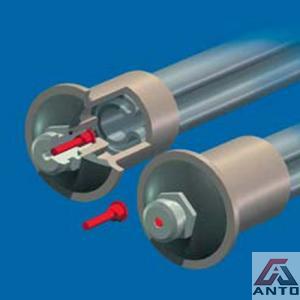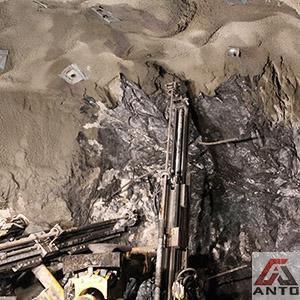Description
Price: Request for a Quote
Size:Pm12, Pm16, Pm24, Mn12, Mn
DESCRIPTION: The mining and tunneling industries have widely adopted the Swellex expandable rock-bolting system.
DESCRIPTION: Descriptions of Swellex
The mining and tunneling industries are well aware of the benefits of the Swellex expandable rock-bolting system. A welded tube that has been folded in on itself and sealed at one end makes up this unusual rock bolt. A specific pump and adapter provide a high pressure water flow that is used to re-expand it. Within the borehole that is drilled into the excavation wall, the bolt is enlarged. Swellex rock bolts are accessible to all operators due to their simple installation procedure, which is quite comparable to other rock bolt installation procedures.
Specifications:
| Description | Bolt Type | Unit | |||||
| Pm12 | Pm16 | Pm24 | Mn12 | Mn16 | Mn24 | ||
| Type of steel | S275JR/S355MC | S355JR | |||||
| Minimum breaking load | 110 | 160 | 240 | 110 | 160 | 200 | kN |
| Minimum yield load | 100 | 140 | 200 | 90 | 120 | 180 | kN |
| Minimum elongation | 10 | 10 | 10 | 20 | 20 | 20 | % |
| Inflation pressure | 300 | 300 | 300 | 300 | 300 | 300 | Bar |
| Profile diameter | 27.5 | 36.0 | 36.0 | 27.5 | 36.0 | 36.0 | mm |
| Original tube, diameter | 41.0 | 54.0 | 54.0 | 41 | 54 | 54 | mm |
| Material thickness | 2.0 | 2.0 | 3.0 | 2 | 2 | 2 | mm |
| Upper bushing, diameter | 28.0 | 38.0 | 38.0 | 38 | 38 | 38 | mm |
| Inflation bushing, diameter | 30/36 | 41/48 | 41/48 | 30/36 | 41/48 | 41/48 | mm |
| Optimal hole diameters* | 35 – 38 | 45 – 51 | 45 – 51 | 35 – 38 | 45 – 51 | 45 – 51 | mm |
| Range hole diameters | 32 – 39 | 43 – 52 | 43 – 52 | 32 – 39 | 43 – 52 | 43 – 52 | mm |
| Connection diameter including welds | — | — | — | — | — | — | mm |
| Recommended collar diameter | — | — | — | — | — | — | mm |
| Bitumen coated option | Yes | Yes | Yes | Yes | Yes | Yes | |
| Plastic coated option | Yes | Yes | Yes | — | — | — | |
Swellex Features:
The Swellex rock bolt is composed of a welded steel tube that has been folded over and sealed at one end. A unique head bushing is positioned at the other end of the tube to retain and inflate the face plates that are normally used in rock bolting.
Instant reinforcement and support are provided by the friction and interlocking anchor that is created by the bolt expanding inside the drilled borehole.
Since Swellex rock bolts offer support and reinforcement along the whole borehole, they can be regarded as full column support.
The Swellex bolt’s distinctive anchorage mechanism allows it to function well in most rock types and adapt to a wide range of ground conditions. Additionally, the steel profile can adjust to shear motions, and the Swellex bolt can withstand significant shear displacements without failing in softer materials.
The system’s performance can be explained by its simplicity. All that needs to be done is for the operator to drill a hole in the rock, insert the bolt, and use a specialized inflation system to inflate it to the desired pressure. When the recommended inflation pressure is reached, the pump cuts off, ensuring a high-quality installation.
Pull testing Swellex rock bolts is a simple process. Of all the rock bolt types, a Swellex rock bolt actually has the simplest pull test operation.
Swellex Applications:
Swellex rock bolts are incredibly adaptable and can be utilized for mining and tunneling, among other types of excavation. Using Swellex pattern bolts to support, reinforce, or consolidate an excavation’s perimeter is a common application in tunneling. The size of the excavation and the rock mass’s ability to support itself determine the bolting density. Common uses in mining include hanging wall bolting and roof bolting. Swellex is a quick and effective stabilization tool. Swellex is not sensitive to hole diameter, rock quality, or water conditions because it expands into boreholes smaller than the folded tube circumference. It also offers a strong anchorage capacity in the majority of tunneling and mining circumstances.
Swellex Face Plate:
The area surrounding the drilling collar is supported locally by face plates. The purpose of the plate in point load anchor bolts is to transfer the displacement of the rock mass into the rock bolt; load transfer is not possible without it. Since the majority of the stress happens along the bolt body, full column support systems such as grouted bolts and friction bolts require a face plate to sustain rock mass loading on the collar alone. Faceplates are utilized to preserve surface support similar to mesh, stop key block movement, and maintain local roof stability.
